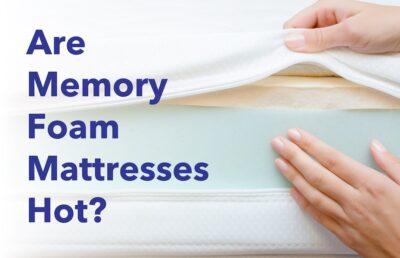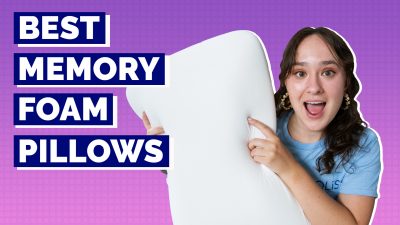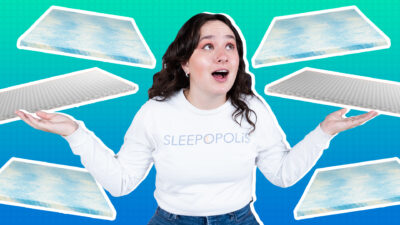Memory foam is truly out of this world. It’s not just because it was initially developed by NASA for use in aircraft seat cushions; as a material, memory foam is gentle, pressure-relieving, and cozy. It only makes sense that it’s incorporated into beds all over the world. The best memory foam mattress works to relieve tension and keep the sleeper cradled in a cushiony embrace.
We’ve gone ahead and highlighted what we’ve found to be the 10 best memory foam mattresses, most of which are dense, contouring, and modified with a cooling infusion or open-cell structure. While we wanted a diverse roundup full of memory foam mattresses with different strengths and weaknesses, we did place an emphasis on testing mattresses ourselves and paying attention to models with good cooling and/or pressure relief. These are generally the two most important factors for comfort on a memory foam mattress.
Note: While a handful of these beds do have a layer of springs in their construction (thus technically making them hybrid mattresses), all of them have a substantial portion of memory foam in the comfort layer and elsewhere.
Our Top Pick for Best Memory Foam Mattress
Nectar tops our list for being an all-foam bed that’s competitively priced, pressure-relieving, and supportive. Unlike many memory foam options, it also sleeps cool.
Best Memory Foam Mattresses 2024
- Nectar – Best Overall Memory Foam Mattress
- Emma Original – Best Memory Foam Mattress for Stomach Sleepers
- Helix Midnight – Best Memory Foam Hybrid Mattress for Couples
- WinkBeds GravityLux – Best Cooling Memory Foam Mattress
- Nolah Signature – Best Memory Foam Mattress for Pressure Relief
- Plank Firm – Best Memory Foam Mattress in a Box
- Bear – Best Memory Form Mattress for Back Pain
- Brooklyn Bedding Aurora Luxe – Best Memory Foam Hybrid Mattress for Side Sleepers
- Dreamfoam Essential – Best Memory Foam Mattress for Back Sleepers
Best Memory Foam Mattress 2024 – Our Video Review

Compare the Best Memory Foam Mattresses
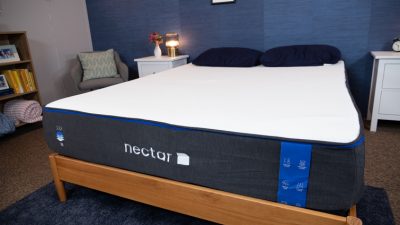
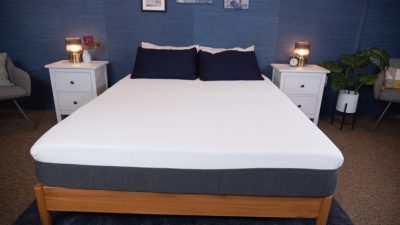
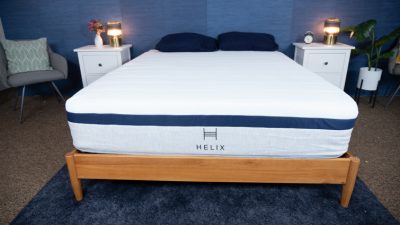
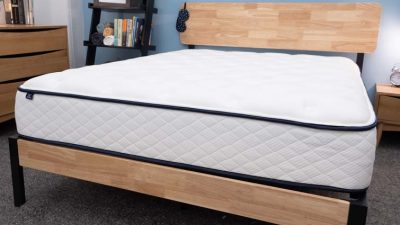
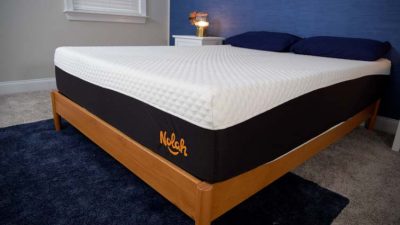
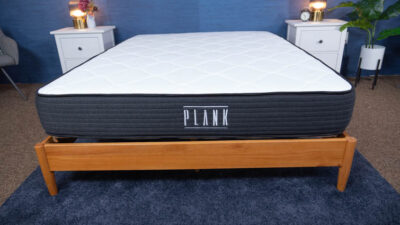
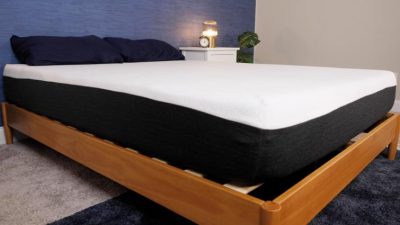
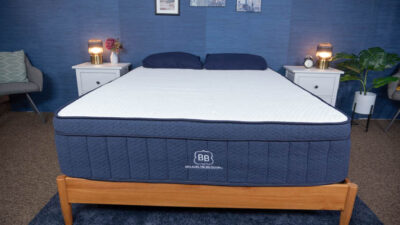

Nectar Mattress
Emma Mattress
Helix Midnight Mattress
WinkBeds GravityLux Mattress
Nolah Signature 12" Mattress
Brooklyn Bedding Plank Firm Mattress
Bear Original Mattress
Brooklyn Bedding Aurora Luxe Mattress
Dreamfoam Essential Memory Foam Mattress
Rating
Firmness
Medium-soft: 6/10
Firm: 7/10
Medium-firm: 6.5/10
Multiple firmness options
Soft: 5.5/10
Multiple firmness options
Firm: 7.5/10
Multiple firmness options
Firm: 7.5/10
Material
Foam
Foam
Hybrid
Foam
Foam
Foam
Foam
Hybrid
Foam
Cooling
--
✓
--
✓
--
--
✓
✓
--
Sleep Position
Back & Side
Back
Back & Side
Back
Back & Side
Back & Stomach
Back & Side
Back & Side
Back & Side
Nectar – Best Overall Memory Foam Mattress
The original Nectar mattress is a pressure-relieving, yet supportive, bed. It’s made with a thick layer of gel memory foam, which allows the sleeper to really sink into its surface.
We recommend this mattress for the following sleeper types: Financing options are available for this mattress. I dreaded paying for a new mattress but my old one was 15 years old…buying a Nectar was the best choice I could have made! It is so comfortable and didn’t cost an arm and a leg. I would absolutely recommend this mattress to anyone!
The original Nectar mattress is a pressure-relieving, yet supportive, bed. It’s made with a thick layer of gel memory foam, which allows the sleeper to really sink into its surface.
We recommend this mattress for the following sleeper types: Financing options are available for this mattress. I dreaded paying for a new mattress but my old one was 15 years old…buying a Nectar was the best choice I could have made! It is so comfortable and didn’t cost an arm and a leg. I would absolutely recommend this mattress to anyone!
The original Nectar mattress is a pressure-relieving, yet supportive, bed. It’s made with a thick layer of gel memory foam, which allows the sleeper to really sink into its surface.
We recommend this mattress for the following sleeper types: Financing options are available for this mattress. I dreaded paying for a new mattress but my old one was 15 years old…buying a Nectar was the best choice I could have made! It is so comfortable and didn’t cost an arm and a leg. I would absolutely recommend this mattress to anyone!
Nectar Mattress

Material
Foam
Trial Period
365 nights
Shipping Method
Free shipping
Firmness
Medium-soft: 6/10
Warranty
Lifetime warranty
Price Range
$$$$$
Joint Pain
This bed is perfect for anyone suffering from joint pain.
Hip Pain
This bed is perfect for anyone suffering from hip pain.
Back Sleeping
Ideal for lightweight and average weight back sleepers.
Side Sleeping
Ideal for lightweight and average weight side sleepers.
Financing Options
Nectar Mattress

Material
Foam
Warranty
Lifetime warranty
Firmness
Medium-soft: 6/10
Shipping Method
Free shipping
Trial Period
365 nights
Price Range
$$$$$
Joint Pain
This bed is perfect for anyone suffering from joint pain.
Hip Pain
This bed is perfect for anyone suffering from hip pain.
Back Sleeping
Ideal for lightweight and average weight back sleepers.
Side Sleeping
Ideal for lightweight and average weight side sleepers.
Financing Options

Nectar Mattress
Material
Foam
Firmness
Medium-soft: 6/10
Trial Period
365 nights
Warranty
Lifetime warranty
Shipping Method
Free shipping
Price Range
$$$$$
Joint Pain
This bed is perfect for anyone suffering from joint pain.
Hip Pain
This bed is perfect for anyone suffering from hip pain.
Back Sleeping
Ideal for lightweight and average weight back sleepers.
Side Sleeping
Ideal for lightweight and average weight side sleepers.
Financing Options
Expert Opinion
The Nectar offers budget-conscious shoppers a memory foam option that doesn’t break the bank (be sure to check for current discounts and coupons). And because it also boasts a quality construction, we had no choice but to set it at the top of our roundup. The Nectar includes three different layers, the first being a cushioning, pressure-relieving comfort foam that’s gel-infused for cooling. The dynamic foam beneath gives a bit of lift and prevents sleepers from sinking too far into the material, while the high-density foam foundation adds support and durability. All together, these three layers provided us with a blend of comfort and support. During testing, we rated the Nectar a 6 out of 10 on our firmness scale (just a touch under medium-firm), so we found it to be comfortable in multiple sleeping positions, appealing to a wide variety of sleepers.
This is also one of our favorite mattresses for joint pain. We actually tested this in our mattress lab using our pressure map test. We lie a pressure map across the mattress surface, and this device uses our body heat when we lay down to determine how much pressure we’re putting on certain areas. The buildup of pressure is measured with colors; areas of low pressure are indicated in blue and green, while areas of moderate to high pressure are indicated in yellow, orange, and red. After testing the Nectar, we found great results for back pain, shoulder pain, and hip pain in the back and side-sleeping positions.
What our tester says: “I felt so comfortable back and side sleeping on the Nectar. It does a great job of cushioning your joints and allowing you to sink into the mattress a little, but it doesn’t totally suck you in and make you feel stuck.” – Bridget Chapman, former senior product editor
What Customers Say
Many customers with back pain have glowing things to say about the Nectar’s ability to alleviate it. Seniors or folks with joint pain also marvel at the Nectar’s ability to relieve pressure from sensitive areas.
Pros of the Nectar Mattress
- The comfort layer of memory foam contoured to our shoulder and hip during testing, so side sleepers’ bodies should receive a good amount of pressure relief in those extra-sensitive areas.
- We felt that the foam gets firmer toward the bottom of the bed, creating a good amount of support and lift for back sleeping.
- Another benefit of memory foam is that it excels at isolating motion. Based on stellar results from our motion isolation tests, you’re unlikely to feel each other’s movements on the Nectar.
Cons of the Nectar Mattress
- Combination sleepers may have a hard time switching positions on the slow-moving memory foam of the Nectar, as we found the memory foam traps the body a bit. We recommend these sleepers check out the best mattresses for combination sleeping.
- Stomach sleepers will likely need a firmer and more supportive mattress. We could feel out backs bow out of alignment while lying in this position.
Learn more in our full Nectar mattress review. You can also click here to get the best deal, or check out our best mattress page for more options.
Emma Original – Best Memory Foam Mattress for Stomach Sleepers
The Emma Mattress is an all-foam bed-in-a-box mattress designed and manufactured in Germany. Its all-foam construction provides great support and comfort that back sleepers and stomach sleepers will enjoy.
We recommend this mattress for the following sleeper types: Financing options are available for this mattress. The Emma Mattress is an all-foam bed-in-a-box mattress designed and manufactured in Germany. Its all-foam construction provides great support and comfort that back sleepers and stomach sleepers will enjoy.
We recommend this mattress for the following sleeper types: Financing options are available for this mattress. The Emma Mattress is an all-foam bed-in-a-box mattress designed and manufactured in Germany. Its all-foam construction provides great support and comfort that back sleepers and stomach sleepers will enjoy.
We recommend this mattress for the following sleeper types: Financing options are available for this mattress.Emma Mattress

Material
Foam
Trial Period
365 nights
Shipping Method
Free shipping
Firmness
Firm: 7/10
Warranty
10-year warranty
Price Range
$$$$$
Hot Sleepers
If you often overheat while you sleep, this mattress should help you stay cool.
Kids
This bed is perfect for young sleepers.
Back Sleeping
Ideal for lightweight and average weight back sleepers.
Financing Options
Emma Mattress

Material
Foam
Warranty
10-year warranty
Firmness
Firm: 7/10
Shipping Method
Free shipping
Trial Period
365 nights
Price Range
$$$$$
Hot Sleepers
If you often overheat while you sleep, this mattress should help you stay cool.
Kids
This bed is perfect for young sleepers.
Back Sleeping
Ideal for lightweight and average weight back sleepers.
Financing Options

Emma Mattress
Material
Foam
Firmness
Firm: 7/10
Trial Period
365 nights
Warranty
10-year warranty
Shipping Method
Free shipping
Price Range
$$$$$
Hot Sleepers
If you often overheat while you sleep, this mattress should help you stay cool.
Kids
This bed is perfect for young sleepers.
Back Sleeping
Ideal for lightweight and average weight back sleepers.
Financing Options
Expert Opinion
Stomach sleepers notoriously need a firm, supportive mattress to keep the hips propped up and in proper alignment. Memory foam mattresses are often soft and not supportive enough for these folks, but that isn’t the case with the Emma Original. We would highly recommend this bed to lightweight or average-weight stomach sleepers, as our testers in this weight category felt super supported in the prone position.
It has a firmness of 7 out of 10, and while this is just slightly above medium-firm, the mattress’ quality materials add to the level of support throughout the night. A responsive transition layer ensures sleepers won’t sink too far into the comfort layer. A super-thick, high-density foam layer creates the base of the mattress, and the foam foundation layer includes zoned support, which is known for promoting spinal alignment and preventing back pain.
What our tester says: “If you crave a supportive foam mattress that still gives you some contouring, the Emma won’t steer you wrong. It features a moderate level of body-contouring and sinkage, but its Airgocell layer balances things out on top.” – Bridget Chapman, former senior product editor
What Customers Say
Many customers shared their appreciation for the generous 365-night trial. The Emma Original might give them a good sleep, but the trial gives them peace of mind.
Pros of the Emma Original Mattress
- As mentioned, we felt this bed suits lightweight and average-weight stomach sleepers. However, its level of support is definitely appropriate for lightweight and average-weight back sleepers as well. And our pressure map shows the Emma properly fills in the lumbar region, adding a bit of cushion to the hips.
- Partners will likely be fans of this mattress, as we found that it’s plenty responsive for sex, provides good edge support, and cools sleepers down quite a bit.
- The cover of the Emma Original is designed for cooling, as it wicks away moisture and also regulates the temperature. Beneath is a comfort layer of pressure-relieving foam that’s open-celled for additional breathability.
Cons of the Emma Original Mattress
- We definitely recommend that larger body types over 250 pounds select a more supportive mattress model. See our best mattresses for heavy people for more options.
- As a more responsive foam mattress, the Emma Original isn’t able to isolate motion as well as other foam mattresses, so it’s not for every pair. For alternatives, check out the best mattresses for couples.
Learn more in our full Emma Original mattress review. You can also click here to get the best deal or check out our best mattresses for stomach sleepers.
Helix Midnight – Best Memory Foam Hybrid Mattress for Couples
The Helix Midnight has a medium support level and bounce that will appeal to a wide range of sleep preferences. The Midnight also does an exceptional job of isolating motion, making it a great choice for couples that move around at night.
We recommend this mattress for the following sleeper types: Financing options are available for this mattress. The Helix Midnight has a medium support level and bounce that will appeal to a wide range of sleep preferences. The Midnight also does an exceptional job of isolating motion, making it a great choice for couples that move around at night.
We recommend this mattress for the following sleeper types: Financing options are available for this mattress. The Helix Midnight has a medium support level and bounce that will appeal to a wide range of sleep preferences. The Midnight also does an exceptional job of isolating motion, making it a great choice for couples that move around at night.
We recommend this mattress for the following sleeper types: Financing options are available for this mattress.Helix Midnight Mattress

Material
Hybrid
Trial Period
100 nights
Shipping Method
Free shipping
Firmness
Medium-firm: 6.5/10
Warranty
10-year warranty
Price Range
$$$$$
Couples
This bed has great motion isolation so you will not feel your partner tossing and turning at night.
Back Sleeping
Ideal for lightweight and average weight back sleepers.
Side Sleeping
Ideal for lightweight and average weight side sleepers.
Financing Options
Helix Midnight Mattress

Material
Hybrid
Warranty
10-year warranty
Firmness
Medium-firm: 6.5/10
Shipping Method
Free shipping
Trial Period
100 nights
Price Range
$$$$$
Couples
This bed has great motion isolation so you will not feel your partner tossing and turning at night.
Back Sleeping
Ideal for lightweight and average weight back sleepers.
Side Sleeping
Ideal for lightweight and average weight side sleepers.
Financing Options

Helix Midnight Mattress
Material
Hybrid
Firmness
Medium-firm: 6.5/10
Trial Period
100 nights
Warranty
10-year warranty
Shipping Method
Free shipping
Price Range
$$$$$
Couples
This bed has great motion isolation so you will not feel your partner tossing and turning at night.
Back Sleeping
Ideal for lightweight and average weight back sleepers.
Side Sleeping
Ideal for lightweight and average weight side sleepers.
Financing Options
Expert Opinion
If you go to Helix’s website, you can take a mattress quiz, which will recommend one of their mattresses from over a dozen different memory foam hybrid models. For couples, we suggest the brand’s most popular model, the Helix Midnight. It has a thick layer of memory foam beneath its cooling top cover, and we found that it absorbs most movement. At the same time, the coils below add some sturdy support for two bodies. Plus, we found the coils make the mattress bouncy in nature so it’s responsive enough for couples to change positions during sex.
When testing out the mattress, we found it very easy to move around, and by sitting and lying on the perimeter, we also found this bed has impressive edge support. Perhaps most important of all, the Helix Midnight went through our motion isolation test. If a mattress has poor motion isolation, you’ll likely feel disturbed by your partner moving around at night. By dropping a 10-pound steel ball from three different heights onto the mattress, we measured the disruption and found low disturbance overall. So, we determined that the Midnight has impressive motion isolation and should suit most couples.
What our tester says: “I thought the Helix Midnight had a slightly softer and responsive feel, which makes it work for a variety of sleepers. It could be a nice solution for two partners who have different sleep positions and need a comfy happy medium.” – Bridget Chapman, former senior product editor
What Customers Say
All around, customers seem to think of this mattress as a well-rounded option. They say that its price, cooling, pressure relief, and support create a balanced and comfortable sleeping space.
Pros of the Helix Midnight Mattress
- While testing this mattress for back-sleeping, we felt our spine supported by the coils and found that the pressure-relieving Memory Plus foam did an excellent job contouring our lower back.
- Likewise, the foam gave us the cushioning and contouring we needed at the shoulder and hip, making this a wonderful choice for side sleepers.
- On top of the Helix Midnight, our testers noticed a Soft Touch cover that we found to be airy and breathable. This helps the mattress keep a cool temperature. This is an important consideration for couples, as two bodies emit more heat than just one.
Cons of the Helix Midnight Mattress
- The main group of people we wouldn’t recommend this mattress for is heavier sleepers over 250 pounds, who may not get the support they need.
- While Helix does offer a decent sleep trial and warranty period, we feel it pales in comparison to other brands out there. For other quality mattresses with good policies, see the best online mattresses.
Learn more in our full Helix Midnight mattress review. You can also click here to get the best deal, or check out our best mattress for couples page for more options.
WinkBeds GravityLux – Best Cooling Memory Foam Mattress
The WinkBeds GravityLux is a memory foam mattress with several different firmnesses available. The WinkBeds GravityLux is a memory foam mattress with several different firmnesses available. The WinkBeds GravityLux is a memory foam mattress with several different firmnesses available.WinkBeds GravityLux Mattress

Material
Foam
Trial Period
120 nights
Shipping Method
Free shipping
Firmness
Multiple firmness options
Warranty
Lifetime warranty
Price Range
$$$$$
WinkBeds GravityLux Mattress

Material
Foam
Warranty
Lifetime warranty
Firmness
Multiple firmness options
Shipping Method
Free shipping
Trial Period
120 nights
Price Range
$$$$$

WinkBeds GravityLux Mattress
Material
Foam
Firmness
Multiple firmness options
Trial Period
120 nights
Warranty
Lifetime warranty
Shipping Method
Free shipping
Price Range
$$$$$
Expert Opinion
While WinkBeds is known for its flagship mattress, which has a traditional innerspring feel, the brand also has a memory foam model called the WinkBeds Gravity Lux. It’s available in several different levels of firmness, and while testing this mattress, we felt it should apply to a wide range of sleepers, including those who tend to overheat at night.
While reviewing the Firm model, we found that its cooling technology should appeal greatly to hot sleepers. It has a cover made of Tencel, an eco-friendly cotton substitute derived from eucalyptus. The material is soft and breathable, in addition to being cool to the touch. Deeper into the mattress, there’s a comfort layer has been constructed with AirCell memory foam — a material with an open-cell design that sleeps much cooler than traditional memory foam.
What our tester says: “Two people create more body heat than one, so couples often prefer cooling mattresses. The GravityLux sleeps much cooler than traditional memory foam mattresses, and I think it’s cooling enough to feel comfortable to couples. But if you sleep very hot, a latex mattress could be a better fit.” – Madison Schaper, former Sleepopolis staff writer and mattress tester
What Customers Say
Even though some customers say the GravityLux was priced a bit higher than other beds, they also mentioned it delivered on quality and was worth the cost. A lot of folks comment on the balanced feel of the WinkBeds Gravity Lux, praising its careful balance of comfort and support.
Pros of the WinkBeds Gravity Lux Mattress
- We found the Firm model to be a 7.5 out of 10 on our firmness scale. This is ideal for back sleepers who need a good amount of support and pressure relief they need.
- Putting this mattress through our pressure map and responsiveness tests, we found more bounce support around the lower back and more softness at the shoulders. This might help lessen back pain and keep your spine in a neutral alignment.
- When we ran the mattress through our motion transfer test, we found it to be adept at isolating motion. So if you share your bed with a partner who’s easily woken up, you should both be able to sleep soundly on this bed.
Cons of the WinkBeds Gravity Lux Mattress
- Heavier stomach sleepers will likely need a firmer and more supportive mattress altogether, such as the WinkBed Plus.
- Winkbeds specializes in budget mattresses, so if you’re wanting a super affordable option, see the best mattresses under $1,000.
Learn more in our full WinkBeds Gravity Lux mattress review. You can also click here to get the best deal, or check out our best cooling mattress page for more options.
Nolah Signature – Best Memory Foam Mattress for Pressure Relief
The Signature is Nolah’s flagship product, and uses the brand’s proprietary AirFoam™ and high density poly foam to achieve a soft yet supportive feel. It's a great bed for those after cushioning and pressure relief.
The Signature is Nolah’s flagship product, and uses the brand’s proprietary AirFoam™ and high density poly foam to achieve a soft yet supportive feel. It's a great bed for those after cushioning and pressure relief.
The Signature is Nolah’s flagship product, and uses the brand’s proprietary AirFoam™ and high density poly foam to achieve a soft yet supportive feel. It's a great bed for those after cushioning and pressure relief.
Nolah Signature 12" Mattress

Material
Foam
Trial Period
120 nights
Shipping Method
Free shipping
Firmness
Soft: 5.5/10
Warranty
Lifetime warranty
Price Range
$$$$$
Nolah Signature 12" Mattress

Material
Foam
Warranty
Lifetime warranty
Firmness
Soft: 5.5/10
Shipping Method
Free shipping
Trial Period
120 nights
Price Range
$$$$$

Nolah Signature 12" Mattress
Material
Foam
Firmness
Soft: 5.5/10
Trial Period
120 nights
Warranty
Lifetime warranty
Shipping Method
Free shipping
Price Range
$$$$$
Expert Opinion
As the flagship mattress of Nolah, the Signature is made from something called AirFoam — essentially the brand’s own take on memory foam. While testing it ourselves, we found this proprietary comfort layer helps the Nolah Signature create enormous pressure relief. This is especially the case for back sleepers and side sleepers, who should get some sinkage mixed with support. When looking at the mattress’ firmness, it clocks in at a 5.5 out of 10, meaning that when we lie down on its surface, it feels very soft and cuddly.
Of course, we had to put the Nolah Signature’s pressure relief to the test. Our pressure map showed that there was only blue and green for back-sleeping, so it should be a great mattress for back sleepers with back pain, shoulder pain, and hip pain. We also tested pressure relief for side sleepers, which we did see more yellow (moderate pressure) on. This should still be plenty comfortable for side sleepers, but perhaps a bit too firm for those with severe shoulder or hip pain.
What our tester says: “If you like the feeling of sinking into your bed, the Nolah Signature could be what you’re looking for. The foam allows for sinkage and for you to feel hugged. This feel can also be alleviating for side and back sleepers who experience back pain.” – Bridget Chapman, former senior product editor
What Customers Say
Many side sleepers and folks with joint pain say that the Nolah Signature is true to the superlative we’ve assigned it. Customers certainly praise the pressure relief on this mattress.
Pros of the Nolah Signature Mattress
- Back sleepers and some side sleepers with joint pain should feel a good deal of sinkage and contouring in areas with higher pressure buildup.
- We found that, true to Nolah’s goal, the AirFoam is a lot more breathable and cooler-sleeping than traditional memory foam. Hot sleepers should have no problem sleeping on the Nolah Signature.
- Some partners should also enjoy how cool this bed sleeps, as well as its strong edge support and how well it isolates motion. However, they should know that the Nolah Signature’s slow-sinking feeling doesn’t make it the best mattress for sex.
Cons of the Nolah Signature Mattress
- Stomach sleepers probably aren’t going to be comfy on the Nolah Signature. They’ll need something with more firmness and support.
- Likewise, heavy sleepers are going to need a sturdier bed. See our best mattresses that won’t sag.
Learn more in our full Nolah Signature mattress review. You can also click here to get the best deal.
Plank Firm – Best Memory Foam Mattress in a Box
The Plank mattress is an all-foam, flippable mattress with a firm side and an extra-firm side, which makes it great for both back sleepers and stomach sleepers. Both sides of the mattress should provide stomach sleepers with the right amount of support needed, while back sleepers will be happiest on the firm side.
We recommend this mattress for the following sleeper types: Financing options are available for this mattress. This is my 4th foam mattress. Lasting firmness is one of the challenges I have come across with the mattresses. This is the most firm I have purchased and after a few weeks, I am still happy.
The Plank mattress is an all-foam, flippable mattress with a firm side and an extra-firm side, which makes it great for both back sleepers and stomach sleepers. Both sides of the mattress should provide stomach sleepers with the right amount of support needed, while back sleepers will be happiest on the firm side.
We recommend this mattress for the following sleeper types: Financing options are available for this mattress. This is my 4th foam mattress. Lasting firmness is one of the challenges I have come across with the mattresses. This is the most firm I have purchased and after a few weeks, I am still happy.
The Plank mattress is an all-foam, flippable mattress with a firm side and an extra-firm side, which makes it great for both back sleepers and stomach sleepers. Both sides of the mattress should provide stomach sleepers with the right amount of support needed, while back sleepers will be happiest on the firm side.
We recommend this mattress for the following sleeper types: Financing options are available for this mattress. This is my 4th foam mattress. Lasting firmness is one of the challenges I have come across with the mattresses. This is the most firm I have purchased and after a few weeks, I am still happy.
Brooklyn Bedding Plank Firm Mattress

Material
Foam
Trial Period
120 nights
Shipping Method
Free shipping
Firmness
Multiple firmness options
Warranty
10-year warranty
Price Range
$$$$$
Back Pain
This bed is perfect for anyone suffering from back pain.
Stomach Sleeping
Ideal for average weight and heavyweight stomach sleepers.
Financing Options
Brooklyn Bedding Plank Firm Mattress

Material
Foam
Warranty
10-year warranty
Firmness
Multiple firmness options
Shipping Method
Free shipping
Trial Period
120 nights
Price Range
$$$$$
Back Pain
This bed is perfect for anyone suffering from back pain.
Stomach Sleeping
Ideal for average weight and heavyweight stomach sleepers.
Financing Options

Brooklyn Bedding Plank Firm Mattress
Material
Foam
Firmness
Multiple firmness options
Trial Period
120 nights
Warranty
10-year warranty
Shipping Method
Free shipping
Price Range
$$$$$
Back Pain
This bed is perfect for anyone suffering from back pain.
Stomach Sleeping
Ideal for average weight and heavyweight stomach sleepers.
Financing Options
Expert Opinion
When we say “mattress in a box,” we mean any bed that can be rolled up, compressed, and delivered right to your doorstep. The Plank Firm — created by Brooklyn Bedding — is a truly impressive bed in a box because it’s so firm. After sleeping on it, you’ll find it hard to believe that it was ever pliant enough to be rolled into a tube-like shape.
It’s also unique in that it’s flippable, with both a firm side and an extra-firm side. The firm side comes in at a 7.5 out of 10 on our mattress firmness scale and the extra-firm side scores an 8.5 out of 10. Despite the firmer feel, the Plank Firm does offer pressure relief for back sleepers and stomach sleepers out there. On our pressure map, we saw mostly green and blue, or lower pressure, at the upper and lower back as well as the hips. This is thanks to its thinner quilted top and layers of comfort foam.
What our tester says: “The Plank Firm gives two distinct options for sleepers who want a firm mattress. However, the firm and the extra firm side mostly appeal to the same type of person. I felt really nice support for my spine and hips while stomach and back sleeping.” – Bridget Chapman, former senior product editor
What Customer Say
Some customers purchased the Plank Firm for their guest room, and they’re happy with this decision because the dual firmness allows them to flip the mattress per their guest’s sleeping preferences.
Pros of the Plank Firm Mattress
- We think stomach sleepers will be comfortable on both sides of the Plank Firm, as each side is extra firm.
- Most back sleepers should be comfortable on the firm side. Even combination sleepers could find both sides to be responsive enough to change positions, as long as they prefer a firm bed.
- It isn’t always easy for folks over 250 pounds to secure a supportive-enough mattress, but the Plank Firm might be just what they’re looking for.
Cons of the Plank Firm Mattress
- This mattress probably isn’t going to work for side sleepers, as we noticed pressure buildup on our map. They’ll likely benefit from a softer mattress with more pressure relief.
- For similar reasons, anyone living with extreme joint pain will likely find increased discomfort on a mattress as firm as the Plank Firm.
Learn more in our full Plank Firm mattress review. You can also click here to get the best deal, or check out our best bed-in-a-box mattress page for more options.
Bear Original – Best Memory Foam Mattress for Back Pain
We appreciate the firm and responsive feel of the Bear mattress. Its combination of support and pressure relief makes it an awesome option for anyone struggling with back pain. The Celliant cover also does a great job of keeping the mattress cool.
We recommend this mattress for the following sleeper types: Financing options are available for this mattress. We appreciate the firm and responsive feel of the Bear mattress. Its combination of support and pressure relief makes it an awesome option for anyone struggling with back pain. The Celliant cover also does a great job of keeping the mattress cool.
We recommend this mattress for the following sleeper types: Financing options are available for this mattress. We appreciate the firm and responsive feel of the Bear mattress. Its combination of support and pressure relief makes it an awesome option for anyone struggling with back pain. The Celliant cover also does a great job of keeping the mattress cool.
We recommend this mattress for the following sleeper types: Financing options are available for this mattress.Bear Original Mattress

Material
Foam
Trial Period
120 nights
Shipping Method
Free shipping
Firmness
Firm: 7.5/10
Warranty
Lifetime warranty
Price Range
$$$$$
Hot Sleepers
If you often overheat while you sleep, this mattress should help you stay cool.
Back Sleeping
Ideal for lightweight and average weight back sleepers.
Side Sleeping
Ideal for lightweight and average weight side sleepers.
Financing Options
Bear Original Mattress

Material
Foam
Warranty
Lifetime warranty
Firmness
Firm: 7.5/10
Shipping Method
Free shipping
Trial Period
120 nights
Price Range
$$$$$
Hot Sleepers
If you often overheat while you sleep, this mattress should help you stay cool.
Back Sleeping
Ideal for lightweight and average weight back sleepers.
Side Sleeping
Ideal for lightweight and average weight side sleepers.
Financing Options

Bear Original Mattress
Material
Foam
Firmness
Firm: 7.5/10
Trial Period
120 nights
Warranty
Lifetime warranty
Shipping Method
Free shipping
Price Range
$$$$$
Hot Sleepers
If you often overheat while you sleep, this mattress should help you stay cool.
Back Sleeping
Ideal for lightweight and average weight back sleepers.
Side Sleeping
Ideal for lightweight and average weight side sleepers.
Financing Options
Expert Opinion
The Bear Original is a firm all-foam mattress that still manages to have some body-contouring, thanks to a memory foam comfort layer infused with graphite gel. We felt a lot of pressure relief in the comfort layer — good news for anyone who struggles with back pain. They should feel the right balance of comfort and support to keep their spine neutrally aligned. Also, the Bear offers a cover made of Celliant that can be added to this mattress for an additional $130. Research suggests this material assists with blood flow and muscle recovery, which is why the Bear Original might be such a good fit for those with an active lifestyle. Its potential healing properties might also help with back pain as well.
We put the Bear Original‘s back pain relief to the test using our pressure map. The results showed entirely blue in the back-sleeping position, which are some promising and incredible results.
What our tester says: “I really appreciate the firm and responsive feel of the Bear mattress. Its combination of support and pressure relief makes it a great option for back sleepers struggling with back pain.” – Bridget Chapman, former senior product editor
What Customers Say
Many combination sleepers like that the Bear has a feel that allows them to move about the mattress without sinking into the layers.
Pros of the Bear Mattress
- The Bear clocks in at a 7 out of 10 on our firmness scale. We think this level of firmness — plus the mattress’ supportiveness — makes it a highly suitable match for back sleepers.
- Because the mattress is so responsive, combination sleepers should be able to easily switch positions at night. We felt ease of movement while rolling around on the Bear Original.
- The Bear’s cooling capabilities make it a good match for couples. It should be able to easily cool down two bodies at once. Couples should also enjoy its ability to isolate motion, plus the responsiveness of the foams make it one of the best mattresses for sex.
Cons of the Bear Mattress
- Strict side sleepers are probably going to find the Bear Original mattress too firm, as evidenced by the results of our pressure map test.
- By contrast, strict stomach sleepers who require more support are better off seeking out a bed with a layer of coils.
Learn more in our full Bear Original mattress review. You can also click here to get the best deal, or check out our best mattress for back pain page for more options.
Brooklyn Bedding Aurora Luxe – Best Memory Foam Hybrid Mattress for Side Sleepers
The Brooklyn Bedding Aurora Luxe is a hybrid bed-in-a-box mattress. It comes in three firmness levels and with an optional Cloud Pillow Top, so sleepers can pick the best model for their needs. It also has cooling tech in nearly every layer, which means it sleeps super cool!
We recommend this mattress for the following sleeper types: Financing options are available for this mattress. The Brooklyn Bedding Aurora Luxe is a hybrid bed-in-a-box mattress. It comes in three firmness levels and with an optional Cloud Pillow Top, so sleepers can pick the best model for their needs. It also has cooling tech in nearly every layer, which means it sleeps super cool!
We recommend this mattress for the following sleeper types: Financing options are available for this mattress. The Brooklyn Bedding Aurora Luxe is a hybrid bed-in-a-box mattress. It comes in three firmness levels and with an optional Cloud Pillow Top, so sleepers can pick the best model for their needs. It also has cooling tech in nearly every layer, which means it sleeps super cool!
We recommend this mattress for the following sleeper types: Financing options are available for this mattress.Brooklyn Bedding Aurora Luxe Mattress

Material
Hybrid
Trial Period
120 nights
Shipping Method
Free shipping
Firmness
Multiple firmness options
Warranty
10-year warranty
Price Range
$$$$$
Hot Sleepers
If you often overheat while you sleep, this mattress should help you stay cool.
Back Pain
This bed is perfect for anyone suffering from back pain.
Side Sleeping
Ideal for average weight side sleepers.
Financing Options
Brooklyn Bedding Aurora Luxe Mattress

Material
Hybrid
Warranty
10-year warranty
Firmness
Multiple firmness options
Shipping Method
Free shipping
Trial Period
120 nights
Price Range
$$$$$
Hot Sleepers
If you often overheat while you sleep, this mattress should help you stay cool.
Back Pain
This bed is perfect for anyone suffering from back pain.
Side Sleeping
Ideal for average weight side sleepers.
Financing Options

Brooklyn Bedding Aurora Luxe Mattress
Material
Hybrid
Firmness
Multiple firmness options
Trial Period
120 nights
Warranty
10-year warranty
Shipping Method
Free shipping
Price Range
$$$$$
Hot Sleepers
If you often overheat while you sleep, this mattress should help you stay cool.
Back Pain
This bed is perfect for anyone suffering from back pain.
Side Sleeping
Ideal for average weight side sleepers.
Financing Options
Expert Opinion
The Brooklyn Bedding Aurora Luxe is a memory foam hybrid, meaning it has a layer of individually wrapped coils at the bottom and softer layers of foam above. There are actually three layers of foam here, which is where the added softness comes from. We rated it at a 6 out of 10 on our mattress firmness scale, which is soft enough to contour side sleepers’ shoulders and hips — the areas of the body where they put the most pressure. We should note that the Aurora Luxe is Brooklyn Brooklyn Bedding’s luxury model, so it has a number of upgraded features such as extra-tall coils and a cover made of cooling Phase Change Material. It’s also available in three different firmnesses: Soft, Medium, and Firm (we tested out the Medium).
To get some more evidence of how the Aurora Luxe would perform for side sleepers, we turned to our trusted pressure map. While on our side, the map was entirely blue at our shoulders, but showed a touch of yellow at our hips. This is something to keep in mind if you’re a side sleeper with hip pain. If so, you might want to opt for the Soft model of the mattress.
What our tester says: “Most side sleepers should appreciate the pressure-relieving sinkage this mattress offers in the Soft model. I also love how it comes in three different firmness models. So, different types of sleepers can pick the best option for them.” – Bridget Chapman, former senior product editor
What Customers Say
There are about 3,300 customer reviews for the Aurora Luxe on Brooklyn Bedding’s website, and the mattress has an average rating of 4.7 out of 5. Almost 40 of these reviews specifically mention side sleeping and how comfortable that position is on the bed.
Pros of the Brooklyn Bedding Aurora Luxe Mattress
- Despite being a softer mattress, the Aurora Luxe is responsive, thanks to its layer of springs. This makes it a good mattress for combination sleepers and one of the best mattresses for sex.
- We think back sleepers should also be comfortable on the Brooklyn Bedding Aurora Luxe. They should get the requisite spinal support from the springs and contouring at the lumbar region from the memory foam.
- The coils allow for a lot of breathability in the mattress, which helps it sleep cool. Almost every layer also has an infusion to further assist with cooling, such as copper and gel.
Cons of the Brooklyn Bedding Aurora Luxe Mattress
- This isn’t a very cheap mattress, so it may not be the best option for budget shoppers. For wallet-friendly models, see the best affordable mattresses.
- Stomach sleepers should opt for the firmer option or peruse the best firm mattresses.
Learn more in our full Brooklyn Bedding Aurora Luxe mattress review. You can also click here to get the best deal, or check out our best mattress for side sleepers page for more options.
Dreamfoam Essential – Best Memory Foam Mattress for Back Sleepers
The Dreamfoam Essential is a very affordable memory foam mattress that is available in multiple heights.
The Dreamfoam Essential is a very affordable memory foam mattress that is available in multiple heights.
The Dreamfoam Essential is a very affordable memory foam mattress that is available in multiple heights.
Dreamfoam Essential Memory Foam Mattress

Material
Foam
Trial Period
120 nights
Shipping Method
Free shipping
Firmness
Firm: 7.5/10
Warranty
10-year warranty
Price Range
$$$$$
Dreamfoam Essential Memory Foam Mattress

Material
Foam
Warranty
10-year warranty
Firmness
Firm: 7.5/10
Shipping Method
Free shipping
Trial Period
120 nights
Price Range
$$$$$

Dreamfoam Essential Memory Foam Mattress
Material
Foam
Firmness
Firm: 7.5/10
Trial Period
120 nights
Warranty
10-year warranty
Shipping Method
Free shipping
Price Range
$$$$$
Expert Opinion
A memory foam mattress isn’t always going to be the best for back sleepers. Some foams just aren’t strong enough to give them the spinal support they need over time. But the Dreamfoam is a bit different from other foam mattresses in that it comes in a variety of thicknesses: 6″, 8″, 10″, 12″, 14″. We think the 12″ and 14″ models could be a good fit for back sleepers, as they’ll be firmer and supportive enough to promote a neutral spinal alignment. This is due to an extra-tall layer of high-density poly foam at the bottom of the mattress, with the softer traditional memory foam up top.
When we tested out the Dreamfoam Essential, we felt comfortable and supported, with the memory foam filling in our lumbar region and the poly foam lifting us up. Overall, we’d rate it at a 7.5 out of 10 on our mattress firmness scale, which is fairly firm.
What our tester says: “I aappreciate the price point of this mattress. No matter which size and height combo you choose, you should be able to get this mattress for under $1,000. ” – Logan Block, former content editor
What Customers Say
There are almost 4,000 reviews on the Dreamfoam Essential’s website, and the mattress has an average rating of 4.7 out of 5 stars. About 350 of these reviews come from confirmed back sleepers, with many of them saying that the Leesa has soothed their back pain.
Pros of the Dreamfoam Essential Mattress
- The responsiveness of the foam made it easy for us to move around and switch positions while testing. So, we think it’s a good mattress for combination sleepers.
- The Dreamfoam is also available in several RV sizes. So if you’re someone who likes to travel, it could be a good fit for your motorized home.
- Manufactured by Brooklyn Bedding (who owns their own factory), the Dreamfoam is very affordable, starting at $524 for a queen size and fluctuating depending on thickness.
Cons of the Dreamfoam Essential Mattress
- This mattress is most likely going to be too soft for heavy sleepers over 250 pounds.
- Being a budget mattress, the Dreamfoam Essential lacks a number of special features and top-tier materials you can easily find in the best luxury mattresses.
Learn more in our full Dreamfoam Essential mattress review. You can also click here to get the best deal, or check out our best mattress for back sleepers page for more options.
Casper
The Casper Original is an all-foam mattress that is a great option for back sleepers who want a balance of support and pressure relief. Combination sleepers will appreciate this mattress's responsiveness, which makes it easy to change positions throughout the night.
We recommend this mattress for the following sleeper types: Financing options are available for this mattress. "From the delivery of the box to the magical unfolding of the king size mattress to the first time laying on the bed, all smiles here! I have traveled for work for years, often sleeping on different beds at different hotels night after night."
The Casper Original is an all-foam mattress that is a great option for back sleepers who want a balance of support and pressure relief. Combination sleepers will appreciate this mattress's responsiveness, which makes it easy to change positions throughout the night.
We recommend this mattress for the following sleeper types: Financing options are available for this mattress. "From the delivery of the box to the magical unfolding of the king size mattress to the first time laying on the bed, all smiles here! I have traveled for work for years, often sleeping on different beds at different hotels night after night."
The Casper Original is an all-foam mattress that is a great option for back sleepers who want a balance of support and pressure relief. Combination sleepers will appreciate this mattress's responsiveness, which makes it easy to change positions throughout the night.
We recommend this mattress for the following sleeper types: Financing options are available for this mattress. "From the delivery of the box to the magical unfolding of the king size mattress to the first time laying on the bed, all smiles here! I have traveled for work for years, often sleeping on different beds at different hotels night after night."
Casper Original Mattress

Material
Foam
Trial Period
100 nights
Shipping Method
Free shipping
Firmness
Firm: 7/10
Warranty
10-year limited warranty
Price Range
$$$$$
Couples
This bed has great motion isolation so you will not feel your partner tossing and turning at night.
Back Pain
This bed is perfect for anyone suffering from back pain.
Financing Options
Casper Original Mattress

Material
Foam
Warranty
10-year limited warranty
Firmness
Firm: 7/10
Shipping Method
Free shipping
Trial Period
100 nights
Price Range
$$$$$
Couples
This bed has great motion isolation so you will not feel your partner tossing and turning at night.
Back Pain
This bed is perfect for anyone suffering from back pain.
Financing Options

Casper Original Mattress
Material
Foam
Firmness
Firm: 7/10
Trial Period
100 nights
Warranty
10-year limited warranty
Shipping Method
Free shipping
Price Range
$$$$$
Couples
This bed has great motion isolation so you will not feel your partner tossing and turning at night.
Back Pain
This bed is perfect for anyone suffering from back pain.
Financing Options
The Casper mattress is an all-foam bed made with three layers that work together to provide pressure relief and support for the lower back, hips, and shoulders. It clocks in between medium-firm and firm on the firmness scale, so it’s soft enough to keep most sleepers’ spines aligned throughout the night.
The bed achieves its balanced feel through a zoned support system. This design makes the foam firmer at certain spots and softer at others. On our pressure map, the Casper showed primarily blue and green in the back and side-sleeping positions, showing that this mattress should work well for joint pain and back pain.
What our tester says: “I think this mattress could be a great fit for back sleepers. Not only is it easy to move around and change positions, but the bed does a great job of positioning the spine in a nice, even line.” – Bridget Chapman, former senior product editor
What Customers Say
Casper shoppers highly value the customer service, saying that Casper representatives are happy to help through every step of the buying process. This includes the decision-making, as well as any delivery issues or refund needs.
Pros of the Casper Mattress
- During our testing process, we found the Casper had solid motion-transfer results. This, as well as its responsive nature (which makes it bouncy enough for sex), makes it a fantastic mattress for couples.
- The responsiveness of the foams makes it easy for combination sleepers to change positions and get comfortable in a short period of time.
- Back and side sleepers should get the amount of comfort and support they need.
Cons of the Casper Mattress
- Stomach sleepers should opt for a firmer and more supportive mattress than the Casper — perhaps something with a layer of coils. While testing, we felt this mattress was too soft for this position, as our hips bowed out of alignment.
- Being an all-foam bed, the Casper traps a bit of heat and doesn’t do nearly as good of a job wicking away moisture as the best cooling mattresses.
Sold on the Casper? Get the best deal online here. Still deciding? Read more about it in our full Casper mattress review.
Who Should Buy a Memory Foam Mattress
- Side sleepers looking for pressure-relieving sinkage should enjoy the feel of memory foam beds.
- Sleepers with joint pain might also like the gentle, cushioning feel of memory foam to help alleviate some pressure at these sensitive points.
- Anyone looking for deep sinkage and body-contouring will enjoy the feel of a memory foam bed. If you’re looking to feel “hugged” by your mattress, this is the material for you.
- Couples often really like memory foam mattresses because they absorb motion well. This means you’re unlikely to be disturbed by a bedmate tossing and turning or getting out of bed.
- Sleepers with latex allergies might want to check out this alternative type of foam mattress.
- Folks who want a mattress that makes no noise will really like how quiet memory foam is.
Who Shouldn’t Buy a Memory Foam Mattress
- If you prefer to feel more “on-top-of” your mattress, you won’t like the sinkage memory foam mattresses provide. You might want to opt for one of our best latex mattresses instead.
- Memory foam has a reputation for overheating at night, mostly because the material is so dense that it has a tendency to trap body heat. This can be highly uncomfortable for some sleepers, particularly those who already run hot. If that sounds like you, check out one of our best cooling mattresses, or opt for a bed that uses special cooling technology like gel infusions.
- Though memory foam’s slow response to pressure can be a big plus for some sleepers, it can be a real drag for others, especially those who like to move around and change positions at night. Any material that has a slow response to pressure is going to produce a quasi-stuck feeling, which limits a sleeper’s overall mobility. Try one of our best innerspring mattresses for responsive options.
Types of Memory Foam
There are many different types of memory foam, and each have their strengths and weaknesses. If you want to get more in-depth, check out our Mattress Layers Guide.
| Foam Type | Description | Image |
| Traditional Memory Foam | – Slower-moving feel – More pronounced hug and contour than other materials – Denser than below options – More likely to overheat than below options – Popular in mattresses sold on Amazon like the Zinus Green Tea | 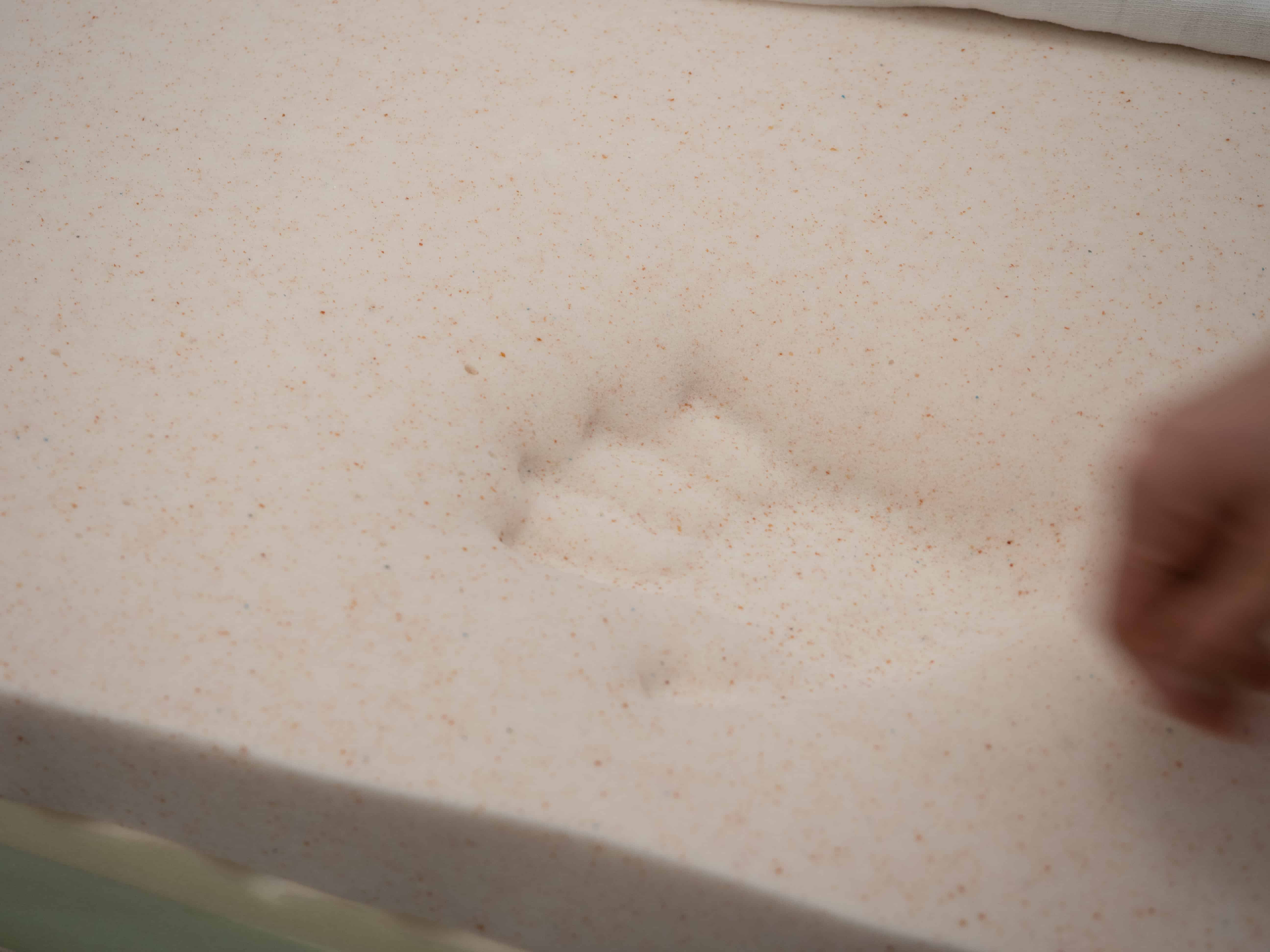 |
| Gel-Infused Memory Foam | – Feels quite similar to traditional memory foam – Slightly less dense – Infused with cooling gel that opens up the structure to promote breathability – Popular in DreamCloud mattresses like the DreamCloud Premier Rest | 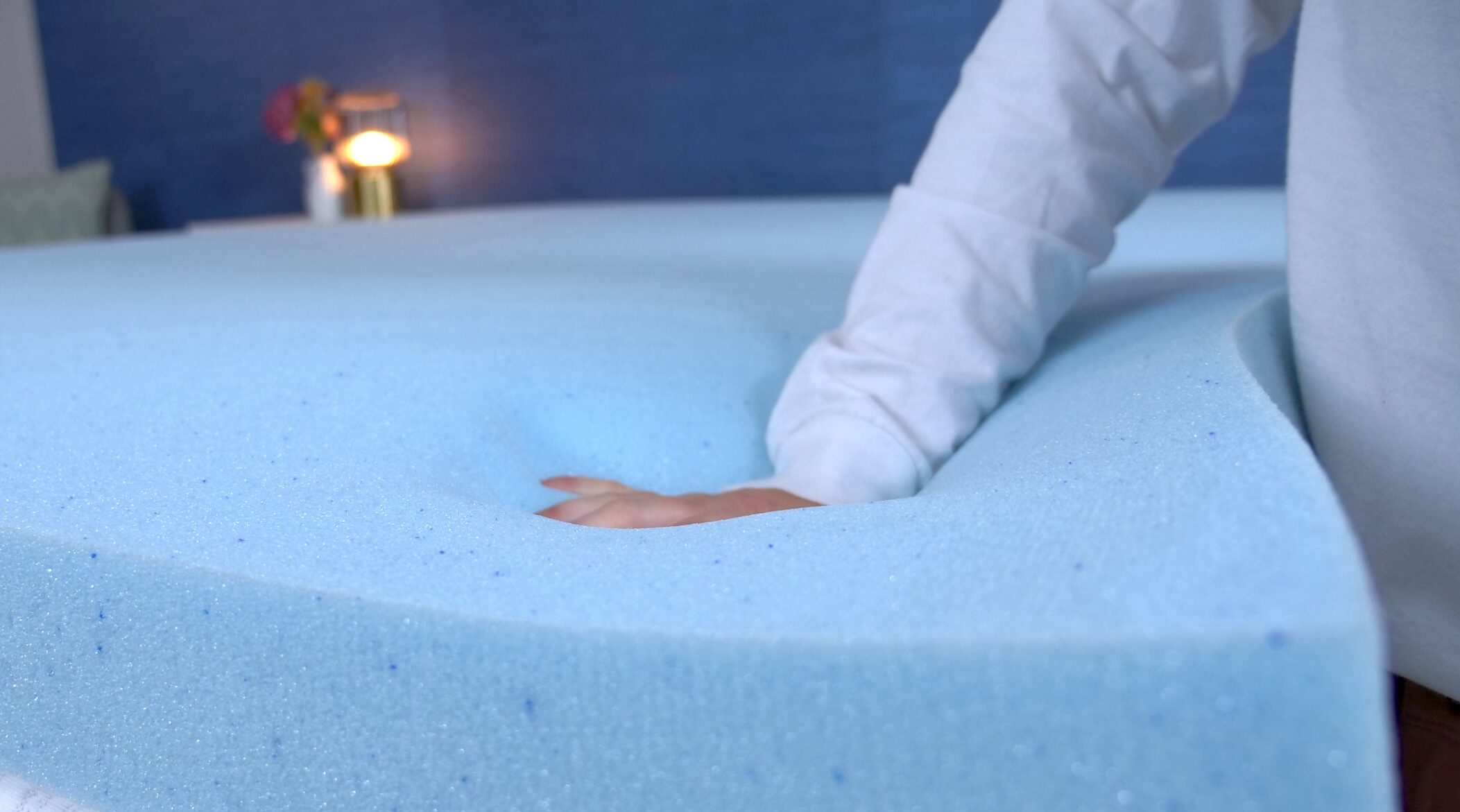 |
| Copper-Infused Memory Foam | – Works similarly to gel infusions to promote airflow – Feels like memory foam but less desne – Uniquely naturally cooling – Popular in Nectar mattresses like the Nectar Premier Copper | 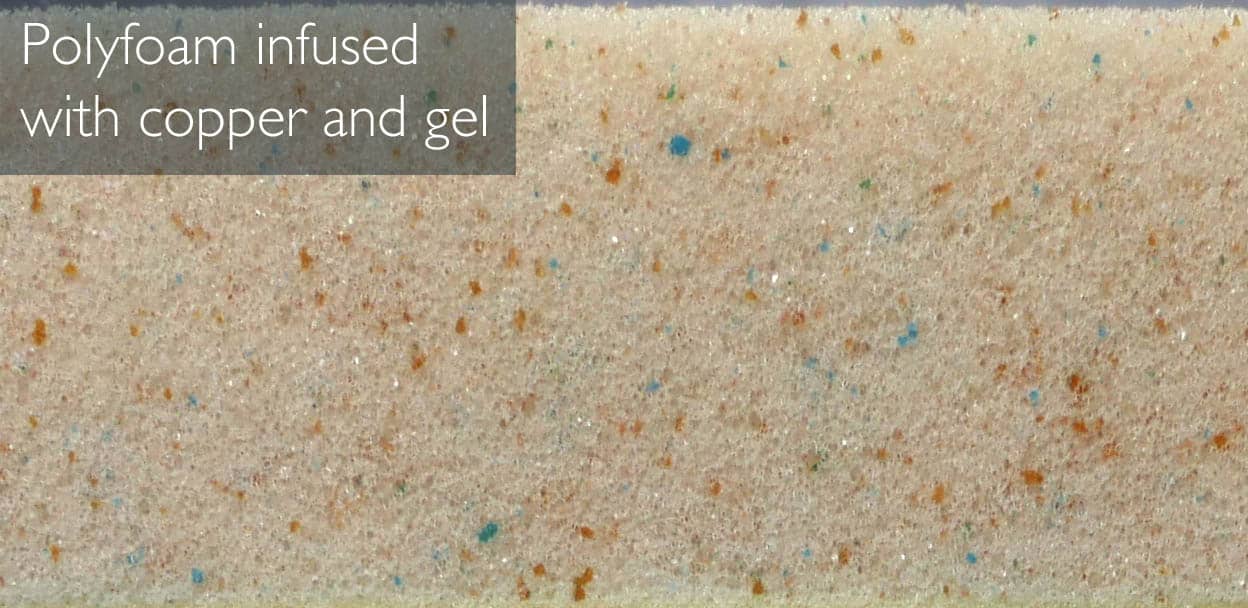 |
| Plant-Based Memory Foam | – Replaces some petroleum products used in traditional memory foam with plant-based oils – Can feel more cooling than traditional memory foam – Preferred by eco-friendly shoppers – Popular in Amerisleep mattresses like the Amerisleep AS3 | 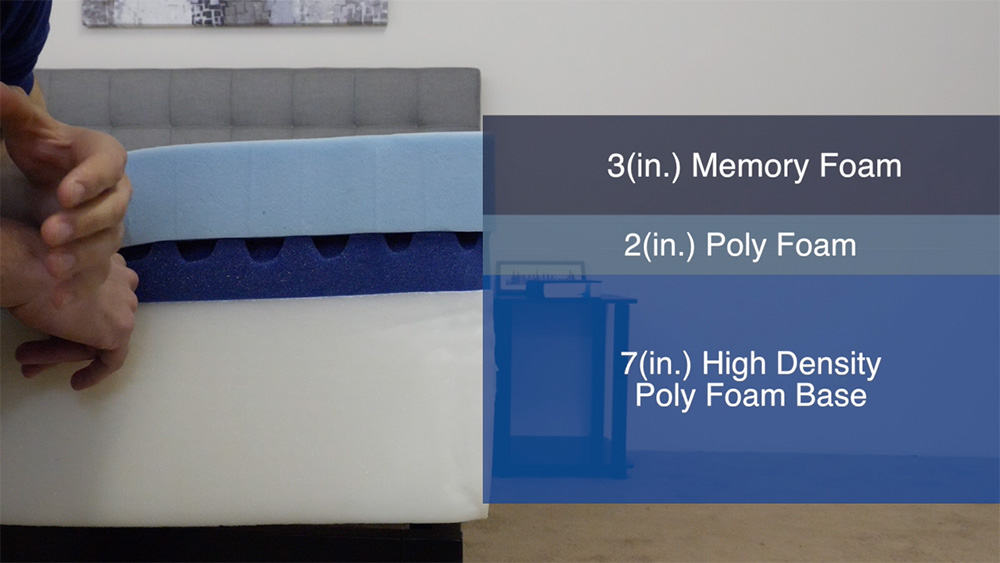 |
| Open-Cell Memory Foam | – Similar feel to traditional memory foam – Uniquely manufactured with tiny air pockets for added breathability – Faster response time and better air circulation – Popular in Helix mattresses like the Helix Plus | 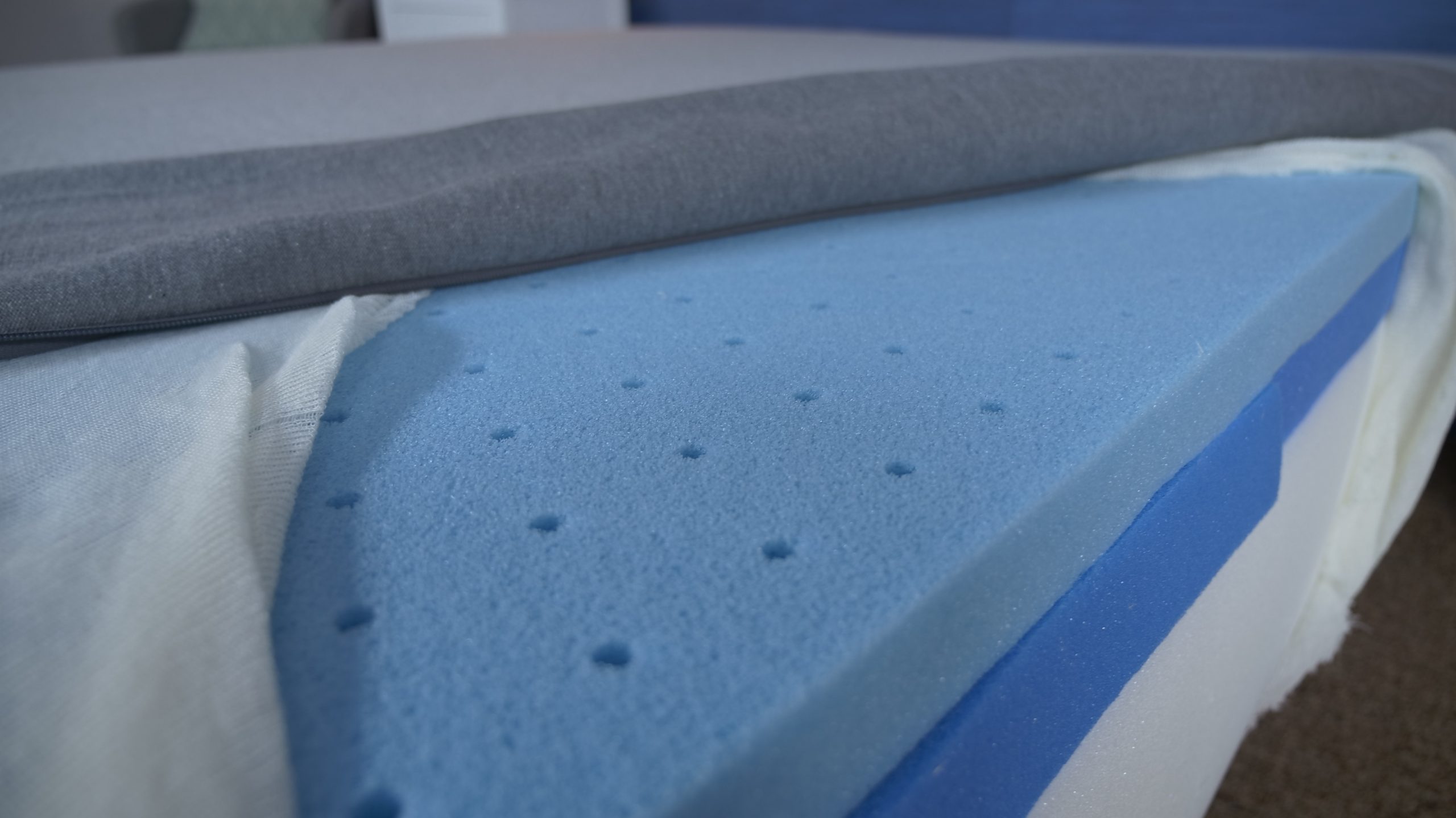 |
Characteristics of Most Memory Foam Mattresses
Memory foam mattresses are one of the most popular constructions out there, alongside hybrid, innerspring, and latex. Read below to see what features of memory foam beds are common across the board. To see how memory foam compares to other types of mattress constructions, see our Mattress Layers Guide.
Contouring
This term describes how memory foam molds and conforms to the curves of the body. That conforming feel is not only comfortable, but also helps alleviate tension at sensitive spots such as the shoulders, hips, and lower back.
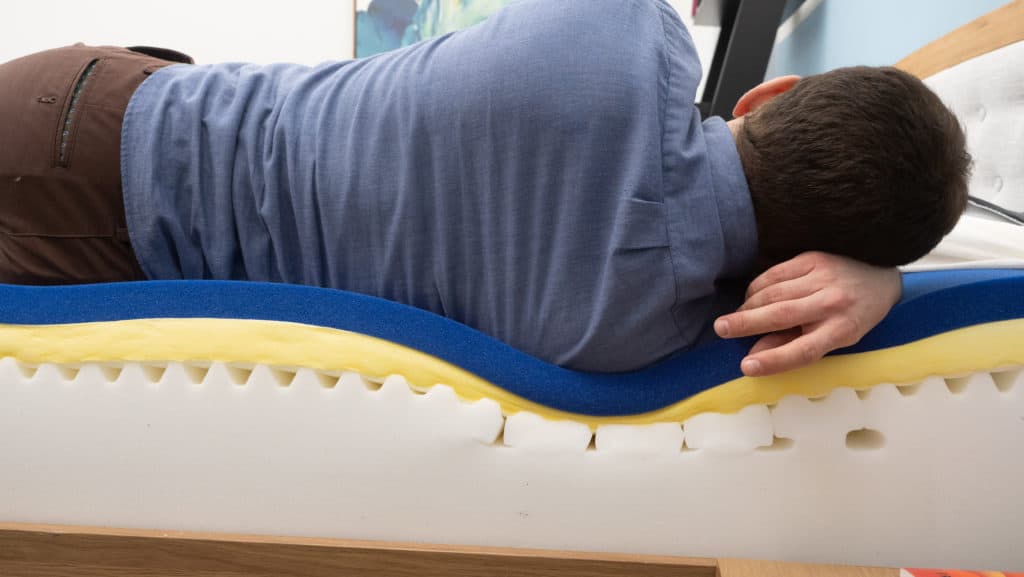
Slow-Sinking
Another hallmark of memory foam is its deep sinkage, which allows sleepers to feel as though they’re being enveloped in a cushioning embrace. Though some may say this results in a “stuck-in-the-bed” feel that makes it difficult to move around, others — such as side sleepers — might feel pain relief and a healthy spinal alignment.
Adaptable
Memory foam is often described as “viscoelastic,” meaning the more pressure applied to the foam, the deeper it will compress. This type of compression doesn’t happen in an instant, but over the course of several seconds (the duration depends on the specific foam).
Other Considerations When Buying a Memory Foam Mattress
Density
Density refers to how much actual foam material is built into the layer of a bed. As a general rule, the higher the density of the foam, the greater lifespan it’s likely to have. However, high-density foam usually sleeps hotter than low-density foam. In my opinion, the sweet spot for memory foam density is in the 3.0–5.0 PCF (pounds per cubic foot) range. This provides enough longevity and durability without being so dense that it creates serious heat-retention issues.
Thickness
To get the classic sinkage and body-contouring feel, you’ll want at least four inches of memory foam, either in one thick layer or several thinner layers. Having less than four inches of foam between your body and the support layer of your bed can create a “support wall” that will minimize the beneficial effects of memory foam.
Indentation Load Deflection (ILD)
This is a measure of how much pressure it will take to compress a piece of memory foam. Foams with a high ILD rating will normally feel initially firmer than foams with a low ILD rating, since it will take more weight to get them to conform to your body. If you’re looking for a soft feel, you can still choose a mattress with a high ILD rating. It’ll just take you a few more minutes to sink into the bed.
Off Gassing
Bed-in-a-box mattresses made with memory foam often have an “off-gassing period,” during which they release any gasses trapped during compression. This isn’t dangerous, but can mean your mattress may smell bad for a few hours. If this is a big concern for you, we’d recommend opting for plant-based memory foams, which often release fewer odors during the off-gassing period.
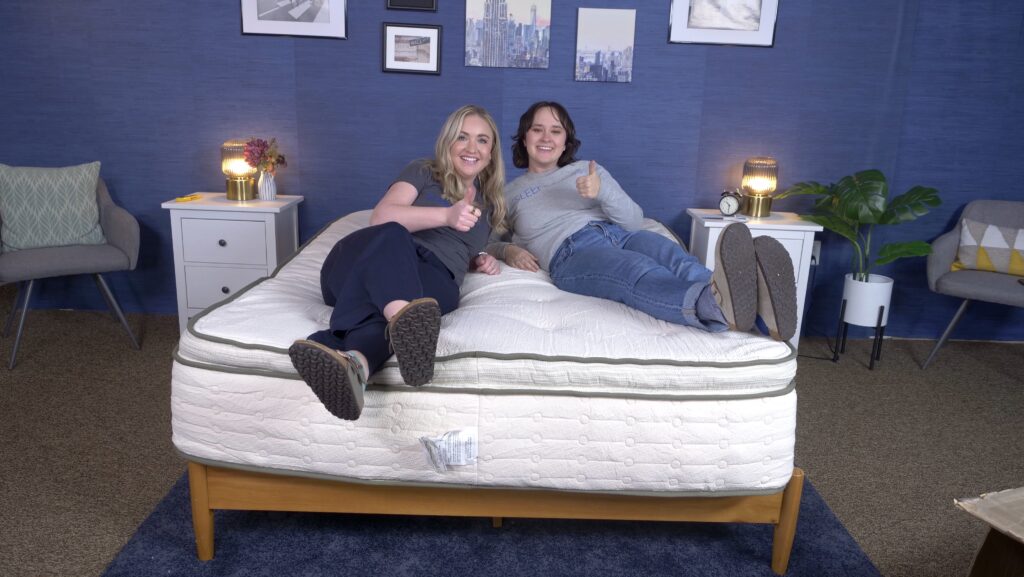
Durability
A lower-quality memory foam mattress should last you three to five years before it starts to sag, and a high-quality memory foam mattress should last about seven to 10 years.
To ensure that your bed reaches its maximum lifespan, we recommend adding a mattress pad and reading our How to Clean a Mattress guide to learn about proper maintenance. Using the proper bed frame or box spring can also extend a mattress’ lifespan. Check out your brand’s warranty information to learn more about what type of frame will work best. Adding a mattress topper to an older mattress can also extend its lifespan by a few years. We’d recommend adding a firmer topper to a mattress that’s starting to sag to add some additional support.
Disposal
When it comes time to get rid of your old mattress, check with the manufacturer to see if they have a removal or recycling policy. Many brands that offer white glove delivery will also remove your old mattress and responsibly take care of it for you. If that isn’t an option, research your local mattress recycling collection centers and see if there’s a drop-off location nearby. And if your bed still has some life left in it, you can donate it to a local charity or shelter. Lastly, you can list your used mattress for free on an online site such as Facebook Marketplace or Craigslist.
What We Test When Reviewing the Best Memory Foam Mattresses
Our team at Sleepopolis believes in physically testing as many mattresses as we can, so we are better able to provide you with expert information. We run our mattresses through a number of tests (cooling, motion isolation, responsiveness, and more), but with memory foam mattresses, we wanted to dive deeper into our testing process for pressure relief. That way, you can get an idea of how sinking and contouring the memory foam is.
Firmness
Like any mattress, memory foam beds can range from soft (1 on our firmness scale) to firm (10 on our firmness scale), with medium-firm (6.5 out of 10) being our average. Generally, we recommend side sleepers choose a soft mattress, back sleepers choose a medium-firm mattress, and stomach sleepers choose a firm mattress.

Motion Transfer
Memory foam is known for being great at absorbing motion, which keeps sleepers from being disturbed by a restless partner. But motion transfer will vary from mattress to mattress, so you’ll want to take it into consideration when choosing between several memory foam beds. In our mattress lab, we test motion transfer in three different ways. One is by dropping a 10-pound steel ball from three different heights, and using a seismometer to measure the level of disturbance.
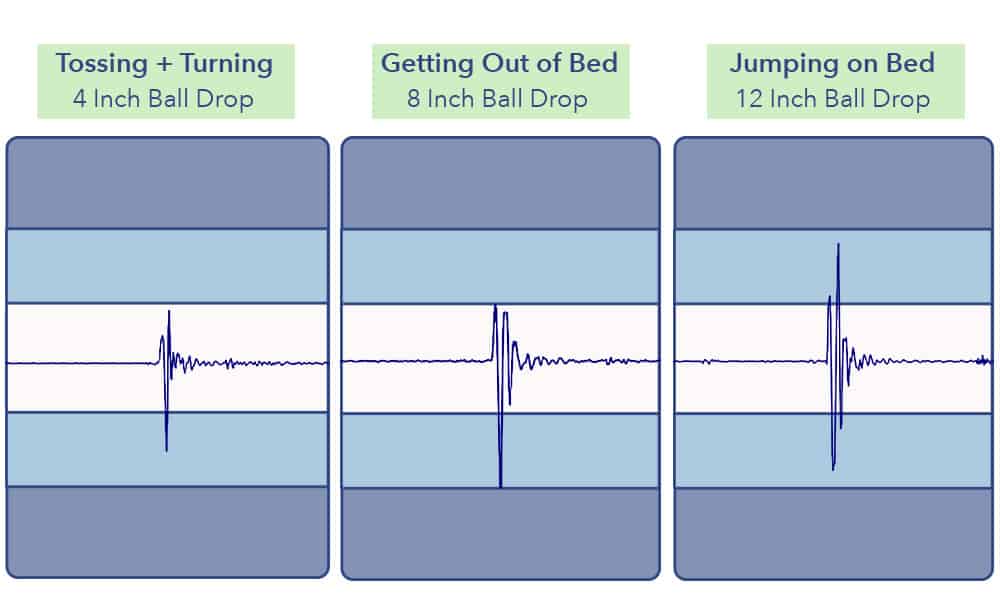
Pressure Relief
Almost all memory foam mattresses offer lots of pressure relief, which aids in enhancing comfort and relieving joint pain. In general, softer memory foam will have a bit more pressure relief than firmer memory foam.
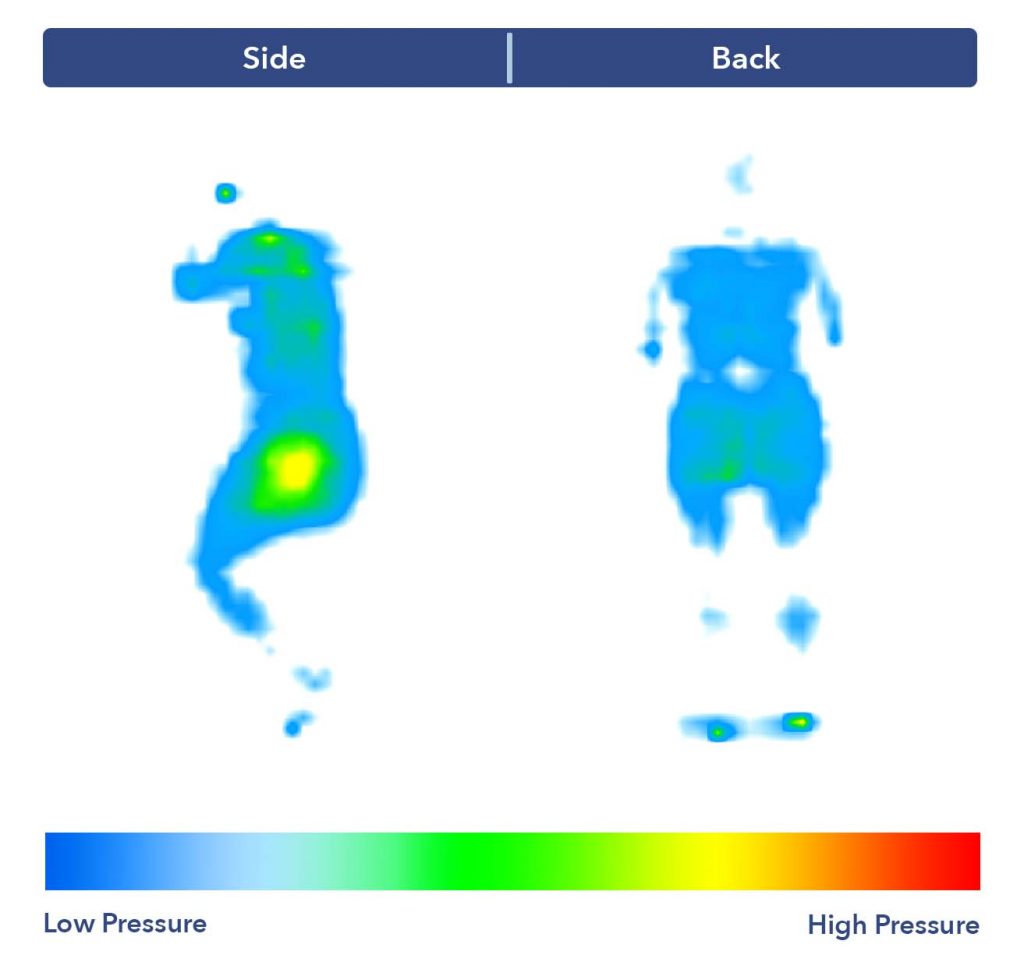
To test this properly, we utilize a pressure map, which is a pad that we place on top of the mattress surface. When we test a mattress out in different sleeping positions, the pressure map uses our body temperature to map our heat and identify areas of pressure buildup. Any parts of the body colored blue suggests low pressure, green suggests moderate pressure, and yellow, orange, and red suggest high pressure.
Above, you can see our pressure map test results for the Helix Midnight. We laid on it in the side-sleeping and back-sleeping positions, and there are images from each. For back sleeping, you can see almost all blue, with the smallest touch of green. This indicates that back-sleeping on the Helix Midnight will likely be an extremely pressure-relieving experience, regardless if you suffer from back, hip, or shoulder pain.
You can see a bit more pressure buildup for side sleepers. There are still magnificent results at the shoulders, but you can see a spot of yellow at the hip. This shows that there’s a little pressure here, which could be felt by some folks struggling with hip pain. With this information, we can conclude that the Helix Midnight is great for back-sleeping and side-sleeping, but side sleepers with hip pain should be a little cautious.
Memory Foam Mattresses for Different Types of Sleepers
Depending on your sleep needs and preferences, you may prefer a specific type of memory foam mattress.
Sleeping Position
First, you’ll want to choose a mattress based off of the way you lay on it throughout the night. Reference the table below to see what mattress firmness best suits your preferences.
| Sleeping Position | Ideal Mattress Firmness | Firmness Scale Level | Why This Firmness? |
| Back sleepers | Medium-firm to firm | 6.5-7/10 | Provides sufficient lift for the hips, yet remains soft enough to offer comfort and alleviate pressure points. |
| Side sleepers | Soft to medium-soft | 5-6/10 | Soft foams ease pressure off of the shoulder and hip, to ensuring the spine falls into a neutral alignment. |
| Stomach sleepers | Firm to extra-firm | 7-8/10 | A firmer bed and extra support helps the hips stay lifted up in line with their shoulders. |
| Combination sleepers | Medium-firm | 6.5/10 | Often accommodates multiple sleeping positions, balancing comfort and support. |
Body Weight
You’ll also want to consider body weight in tandem with sleeping position, as people of different weights are going to feel the same materials and mattresses firmnesses differently.
| Body Weight | Weight (Pounds) | Keep In Mind |
| Lightweight sleepers | 130 pounds or less | These folks aren’t as likely to sink through materials as easily as others |
| Average-weight sleepers | 130–250 pounds | These sleepers are likely to feel a mattress as presented on the firmness scale |
| Heavy sleepers | 250 pounds or more | Pay attention to extra-durable materials and sufficient support |
FAQs
What thickness of memory foam is best?
On average, we recommend purchasing a memory foam mattress with a thickness of 10 to 12 inches. But truly, it depends on the sleeper. Folks who are lighter in weight won’t compress through the mattress layers as much as others, so they’ll likely be comfortable on as little as eight inches. Sleepers over 130 pounds should consider a bed that’s somewhere around 10 to 13 inches.
Do you need a box spring with a memory foam mattress?
Totally up to you. You don’t need a box spring for any of the mattresses mentioned in this list, but if you prefer the feel of a box spring to that of a traditional bed frame, feel free to go with it. We do always recommend checking with the manufacturer to make sure you’re using the right type of mattress base so it doesn’t void the warranty.
Can you flip a memory foam mattress?
It depends on the bed. Some memory foam mattresses are flippable, so will work regardless of how you orient them. Others, however, aren’t designed to be flipped at all as they only feature memory foam on one side of the bed.
Should my memory foam mattress have a warranty and sleep trial?
Warranty length and sleep trial periods are two important things to consider when choosing a new mattress. In general, we recommend looking for a company that offers at least a 10-year warranty and 100-night (or longer) sleep trial. These are both great indications that you’re buying from a reputable mattress brand that stands behind their products and protects you, the customer.
How much should I pay for a memory foam mattress?
A queen size memory foam mattress can cost anywhere from about $500 to $3,000. Most of the mattresses we chose for this roundup land in the middle of this range, which we think is a fairly average price for a high-quality memory foam mattress.
For better deals, check out our Sleepopolis coupons page or keep an eye out for company discounts. Most brands run sales throughout the year, with many falling in line with holidays such as Black Friday, Memorial Day, and Labor Day. And of course, we’ll always keep you informed on Facebook, Twitter, and YouTube about the latest deals so you can find the bed that’s 100 percent right for you.
Is a memory foam mattress good for back pain?
It really depends on how you sleep. Though most memory foam mattresses will probably be too soft for strict back sleepers, side sleepers with aches and pains in the lower back may find that a memory foam mattress is able to alleviate tension along the spine. If you are struggling with pain at night be sure to look at the top mattresses for back pain.
What are the disadvantages of memory foam mattresses?
Memory foam mattresses often get a bad reputation for trapping heat, sagging easily, and limiting sleepers’ mobility. However, many modern manufacturers include high-quality foams, cooling gel infusions, or more responsive transition foams to solve each of these issues.
How We Chose These Mattresses
Our team of Certified Sleep Science Coaches has reviewed more than 300 products in Sleepopolis’ mattress lab, running each one through tests such as pressure-mapping and measuring motion transfer with a seismometer. From there, we give every bed an overall score based on materials, comfort, support, cooling, and edge support. We also factor in brand performance with categories such as value and warranty.
When selecting beds for our roundup of the Best Memory Foam Mattresses, we took an extra-close look at the category of materials. As comfortable as memory foam is, it can be tricky when it comes to areas such as cooling and support, so it’s important that the materials in each bed have an effective balance of these traits. All of the products reviewed on this page scored at least a 4 out of 5 on materials. Click here to learn more about our methodology.
Best Memory Foam Mattresses of 2024
| Mattress | Best | Price After Discounts (Queen) | Coupon | Review |
|---|---|---|---|---|
| Nectar | Best Overall | $1,049 | Nectar Coupon | Read Our Review |
| Emma Original | Memory Foam for Stomach Sleepers | $1,053 | Emma Coupon | Read Our Review |
| Helix Midnight | Memory Foam Hybrid for Couples | $1,373 | Helix Coupon | Read Our Review |
| WinkBeds GravityLux | Cooling Memory Foam | $1,799 | WinkBed Coupon | Read Our Review |
| Nolah Signature | Memory Foam for Pressure Relief | $1,799 | Nolah Coupon | Read Our Review |
| Plank Firm | Memory Foam in a Box | $1,332 | Brooklyn Bedding Coupon | |
| Bear Original | Memory Foam for Back Pain | $998 | Bear Coupon | Read Our Review |
| Brooklyn Bedding Aurora Luxe | Memory Foam Hybrid for Side Sleepers | $1,865 | Brooklyn Bedding Coupon | Read Our Review |
| Dreamfoam Essential | Memory Foam for Back Sleepers | $524 | Brooklyn Bedding Coupon | Read Our Review |
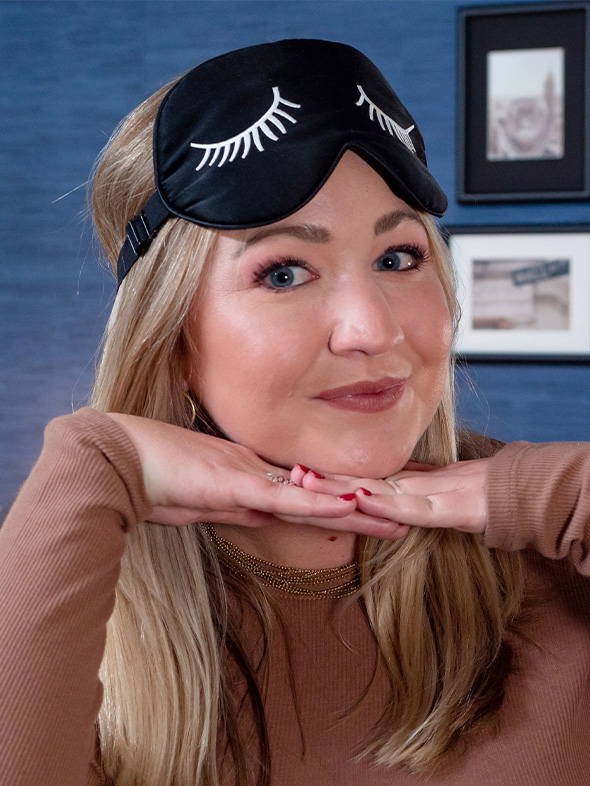
Bridget Chapman
Former Senior Product Editor
About Author
Bridget is a Certified Sleep Science Coach and senior editor here at Sleepopolis. From testing mattresses to writing about various sleep health topics, her goal is to help you get a good night’s sleep. You can also find her in videos on our YouTube channel. Bridget graduated magna cum laude from San Diego State University with a degree in journalism and a minor in English. Before joining the Sleepopolis team, she was a TV news reporter and worked in cities across the country. She loves spending time outdoors, checking out new restaurants, snuggling with her pets, and of course — getting some quality Zzz’s.
Combination Sleeper
Sources
Gordon Ian L. Effect of shirts with 42% Celliant™ fiber on tcPO2 levels and grip strength in healthy subjects: A placebo-controlled clinical trial. Journal of Textile Science and Engineering. 2019. https://www.ncbi.nlm.nih.gov/pmc/articles/PMC8351537/
